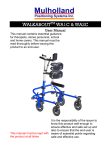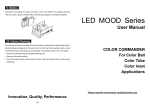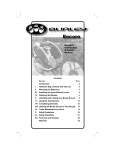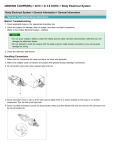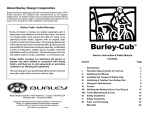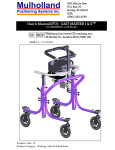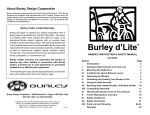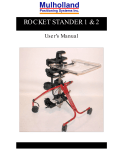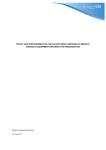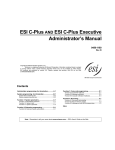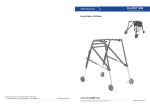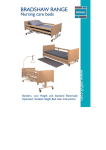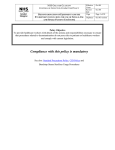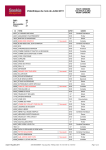Download Walkabout 3 and 4 - a1active.co.uk
Transcript
WALKABOUTTM WA3C & WA4C User Manual This manual contains essential guidance for therapists, stores personnel, school and home carers. This manual must be read thoroughly before issuing this product to an end-user. It is the responsibility of the issuer to know this product well enough to ensure effective and safe set up and also to ensure that the end-user is This manual must be kept with aware of essential points regarding the product at all times safe and effective use. Table of Contents Preface 3 Design Goals 3 Safety Information 4-6 Precautions 7 Components 8 Assembly 9-12 Adjustment Overview 13 Fitting Instructions 13-19 Measure the Child 13 Sit Bar, Hip & Upper Trunk Supports 14 Upper Body Pitch 15 Column Height 16 Spring Tension 17 Swivel Caster Lock & Adjustable Length Base 18 Width Adjustable Base 19 Headrest 20 Anti Reverse Brake 20 Options / Accessories 21-27 Hand Holds & Arm Troughs 21 Clear Tray Assembly 22 Abduction Skirt 23 Unicycle Saddle Seat 24 Shoulder Pads 25-26 Neck rest 27 Service & Warranty 28 / 44 Product Induction and Issue Directive 29-31 Using the Walkabout™ 32-37 Maintenance / Cleaning 38-39 Reissuing / Annual Inspection / Fastener Check 40-43 Product Log 45-46 Specification 47 2 Preface This manual provides the information required for the set up and use of the WalkaboutTM 3C & 4C. This manual is for the EU users. The benefits of using this system can be profound, not only in terms of gait development, but also in terms of increasing the child’s independence, self confidence and social interaction. Design Goals The WalkaboutTM is designed to give a child the potential for handsfree, self-initiated movement while providing lateral support and assisted lift. This spring-assisted lift allows for graduated weight relief as the child develops skill and standing tolerance. The adjustable “pitch/ angle” of the column, along with the pelvic and trunk supports, can be utilized to direct weight shift and assist with stepping. Key For EU Users T Technical User : Therapist C School & Home Carer S Store Personnel 3 Before Starting T C S Important • • • • • • • • • • • • • • • • 4 This WalkaboutTM should be used under the prescription and direction of the child’s therapist. Always read instructions before use. Failure to follow instructions may impair use, impede function and more importantly may affect the user’s safety. This user guide is for Walkabout TM, item Code: WA2C & WA3C. Each product has a serial number which will be found on the base. Please quote this number in all correspondence. This product conforms to CE Marking Regulations, Medical Devices Directive (MDD) 93/ 42 EEC, Do not add any other accessories other than those supplied by Mulholland to this product. Ring your local dealer for advice if unsure. The warranty conditions are stated on page 44 and provide further information. WA3C: maximum user weight 68Kg. WA4C: maximum user weight 86Kg. Service or repair must only be carried out by a Mulholland authorised service person / local dealer. Any service or repair carried out by any other person will invalidate the guarantee and Mulholland cannot accept any liability for injury or damage thus caused. The tools required to adjust Walkabout TM are supplied with the product. These adjustments are to be made by the therapist only. Store these in a safe place. Keep away from children. The WalkaboutTM should only be setup by the therapist. Ensure that the product is fully assembled before use. Contact your local dealer if you need advice at this stage. Frequently check and tighten all loose fasteners. Loose fasteners can cause the WalkaboutTM to be inoperable. See Pages 40-43 It is essential that the Walkabout TM is cleaned regularly so as not to impede function and to remain hygienic. Use warm soapy water but not abrasive detergents. See Page 39 Please ensure the WalkaboutTM is set up as per instructions. Ensure that induction / hand over procedures as described on page 29 are undertaken. Before Starting T C S Safety • • • • • • • • • • • • It is imperative that children are continuously monitored whilst using the WalkaboutTM. NEVER LEAVE A CHILD UNATTENDED IN THIS PRODUCT. If there is the slightest concern regarding the supports, use or function of the product then immediately contact your local dealer. All adjustments should be carried out prior to transferring the user into the WalkaboutTM. Only the fine height adjustment through the crank lever at the top of the rear column should be carried out with the user in the WalkaboutTM. Ensure wheels are always locked when transferring the user into the WalkaboutTM. The rear anti-tip wheel can be lower to provided additional stability. However, raise the wheel before using the WalkaboutTM. The anti-tip wheel should clear the floor by 1”/ 25mm. Once the user is transferred into the Walkabout TM, secure the chest and pelvic straps immediately. When doing a hoist transfer, please ensure that the hoist sling is not caught on any part of the WalkaboutTM. Due to the nature of the product, please be aware of the length of the base and the surroundings in which the Walkabout TM is being used. Do not allow other individuals to use, play with, stand on, ride on or run around the WalkaboutTM. Please be aware of the spring mechanism on the rear column, as fingers may accidentally get pinched. Please ensure the WalkaboutTMis used on a level and even surface. The WalkaboutTM should not be used near a slope, stairs or a swimming pool. Beware of obstacles ( curb, door stop, drains ) which can cause issue with WalkaboutTM stability. Adjust the base frame length to suit conditions of use and the stature of the user. Promote good hygiene. Do not allow the child to eat or suck the webbing straps 5 Before Starting T C S Safety • • • • • • • • • • • • • 6 Beware of the user’s excessive speed and the surroundings. Do not exceed the maximum user weight or the maximum height adjustment. As the child develops walking and independence, be aware of hazards and skills that the child has not yet learnt, e,g hot surfaces, electrical items etc. The ball lock pins must be engaged at all times and the T-nut must be secure. Always use both the securing mechanism at all times. Failure to use the ball lock pin will allow the rear column to slide downwards causing injury to the user. See page 37 When a sit bar / double sit bar or seat is used, ensure the ball lock pin is engaged and the T-nut is tight. Failure to secure the support may allow the user to slide through the supports causing injury to the user. Ensure that the user does not get their feet caught under the base or the wheels. Ankle straps can be fitted to the Walkabout TM. Please ensure appropriate footwear is used for walking in the WalkaboutTM. Ensure the user does not get their head around the side of the headrest, a wider headrest can be provided. Strong involuntary movement or seizures may cause stability issues. DO NOT LEAVE CHILD UNATTENDED IN WALKABOUTTM Beware some users may accidentally undo the chest and pelvic buckles. If the user is able to undo the buckles and there is a risk of the user falling out of the Walkabout TM, please immediately contact your local dealer for advice and stop using the Walkabout TM. Small parts if loose will be a potential hazard for small children. Keep products away from sources of heat such as naked flames, cigarettes, open fires, heaters, radiators etc.. The safety advice and directions in this manual cannot cover all eventualities and unforeseen situations that may occur. It must be understood that common sense, general caution and care are factors that cannot be built into this product. These are factors which the person actually using this product must assume responsibility for. Precautions T C S Before transferring the user into the WalkaboutTM, ensure initial checks are carried out as directed on Page 28. Ensure the user is well supported when transferring into the WalkaboutTM. Always use all the straps provided, Ensure the chest and pelvic straps overlap each other by minimum of 2”. Always secure the secondary plastic buckle on the chest and pelvic straps. Please ensure that items of clothing and hair are fastened away, so as not to impede or, get caught in the Walkabout TM spring mechanism. This device is NOT to be used as a transportation device especially in motor vehicles. Never make any tilt adjustments with the child in the WalkaboutTM. The rear anti-tipper wheels need to be at least 1 inch (2.5cm) off the floor. If they are contacting the floor, the user cannot turn in the device. Adjust the height of the seat prior to putting the user in the WalkaboutTM. Adjust the spring tension after the user has been transferred into the WalkaboutTM. If the rear column tilts forward spontaneously correct the angle and TIGHTEN the clamp screws. See Page 42. 7 WalkaboutTM Components 1. Headrest 2. Trunk support 3. Pelvic support 4. Seat 5. Direction Lock 6. Anti reverse 7. Brake 8. Anti tipper wheels 14 T S 9. Column Brace 10.Column height adjustment tube 11.Tube adjustment clamps 12.Front Column 13.Rear Column 14.Crank 15. Shock absorber 16.Spring stop assembly Figure 1 16 1 12 15 2 13 3 9 4 10 11 6 7 5 8 8 C Unpacking & Assembly T S Unpack the box carefully, Walkabout TM is shipped in 3 Parts (base, front and rear column assembly, and column adjustment tube with the rear tipper wheels) plus accessories. Carefully remove all the parts from the box and check you have all the parts you have ordered. Keep bubble wrap and polythene bags away from children Tools Required: • • • • 3/16” Allen wrench (included in pouch) 5/32” Allen wrench (included in pouch) 1/4” Allen wrench (included in pouch) Tape measure Common Adjustment Fasteners Adjustment Levers: Refer to Figure 2. The adjustment levers can be ratcheted so that the handle can rotate without affecting the tightness of the screw. 1. Pull out on black knob. Rotate the handle so it is not obstructed. 2. Release the black knob, and let the handle slide back and lock with the screw. 3. Continue tightening/loosening the screw by rotating the handle. Figure 2 Ball Lock Pins: Refer to Figure 3. 1. Hold the pull ring of the pin with your index finger. 2. Pull on the ring to extract, or push the pin to insert. Figure 3 9 Assembling The Walkabout TM T Column Adjustment Tube: Refer to Figure 4. 1. Place the base assembly on the floor and apply the brakes. 2. Loosen the rear eight Allen screws on each of the 2 tube adjustment clamps (1). Figure 4B. 3. Remove the front two Allen screws from each of the 2 tube adjustment clamps (2). 4. Slide the column adjustment tube (3) through the tube clamps. 5. Replace the front two Allen screws on the tube adjustment clamps. (Do not tighten yet) 6. Position the column adjustment tube (3) so that the anti-tipper wheel (4) is at least 1” from the ground. Figure 4C. 7. Tighten the front two Allen screws first, and then tighten the back four screws until they are “snug.” S 3 1 2 Figure 4 Figure 4B Do not over tighten the screws, this will cause the column adjustment tube to buckle and inhibit adjustment! Having the anti-tipper wheels on the ground will make it extremely difficult for the user to turn in the unit. Note : the column adjustment tube (3) is mounted inside the base - with the wheel on the outside. 3 4 1” Figure 4C 10 Assembling The Walkabout TM T S Spring Stop Assembly Refer to Figure 5. 1. Place the rear column flat on the ground. 2. Remove the ball lock spring from the spring stop assembly. (1) 3. Align the fixing hole in the spring stop assembly with the hole in the rear column. 4. Reinsert the ball lock pin through the spring stop assembly and the rear column. Exercise caution when aligning the spring stop assembly onto the rear column, as the spring may pose a finger trap. 1 2 Figure 5 Column Refer to Figure 6. 2 1. Loosen the T-nut (1) and pull the column adjustment plunger /ring (2) on the rear column adjustment tube. 2. Slide the rear column (3) into the column adjustment tube. 3. Release the plunger and tighten the T-nut to secure the rear column to the base. Ensure the column adjustment plunger has fully engaged with the selected hole on rear column and the T-nut is tight. 1 3 Figure 6 11 Assembling The Walkabout TM T Completed Assembly: Refer to Figure 7. Figure 7 12 S Adjusting The WalkaboutTM AJUSTMENT OVERVIEW T Correct adjustment of the WalkaboutTM will significantly improve the child’s success. The therapist is encouraged to try various adjustment combinations. As the child’s skill improves, adjustments should be made to decrease the amount of assistance. Key Adjustments: • Column Tilt (Pitch / Angle): Affects the child’s orientation in space and can affect posture and tone. • Column Height: Affects the degree of assistance that the stander provides (in addition to spring tension) • Pelvic and Trunk Supports: Provide precise proximal stability. These components also provide some of the fine tuning for trunk alignment and control. • Spring Tension: Spring support can be increased or decreased by turning crank (refer to the Components section for location Page 8) FITTING INSTRUCTIONS Taking the following measurements will ensure the Walkabout TM is set up correctly for the user. Measure the Child: 1. Trunk width: _________ 2. Hip width: _________ 3. Inside Leg to 1” below his/her axilla: _________ 4. Inside Leg to floor : _________ 13 T Adjusting The WalkaboutTM Sit Bar, Pelvic & Trunk Supports: Refer to Figure 8. 1. Open the front of the pelvic & trunk support straps by releasing the buckles, and unfastening the velcro. 2. Loosen the four Allen screws (1) on the back of the sling bar clamps. 3. Adjust the width of the trunk bars to accommodate the trunk width measurement). The bars should be symmetrical on both sides. Tighten the four Allen screws.(1) 4. To adjust the width of pelvic support to required measurement, repeat steps 2 & 3. 5. Seat height: Loosen the 4 Allen screws (2) and slide the seat along the front column. Initially, place the seat as high as possible on the column. Retighten the screws. 1 4 3 2 Figure 8 6. Pelvic support height: Loosen the two adjustment levers (3) on the back of the clamp plates. Place the pelvic support assembly as close to the seat as possible without preventing hip flexion. If this support is too high or too low, it will not provide the stability required for the child to step forward. Tighten both levers. 7. Trunk support height: Loosen the two adjustment levers (4) on the back of the clamp plates. Position the trunk support so the distance from the top of the trunk support to the top of the sit bar is equal to the required measurement. Tighten both adjustment levers. After adjusting the sit bar, ensure the ball lock pin is completely engaged in the selected hole and T-nut is tight. Failure to secure the bar properly may allow the user to slide through the pelvic and trunk supports causing injury to the user. 14 T Adjusting The WalkaboutTM Pitch: Refer to Figures 9 & 10. The child’s shoulders should be positioned slightly in front of the lower body and feet (in most situations) with the pitch of the column at approximately 85 degrees to the floor. Occasionally the column will be positioned in a more upright, or more prone position, to improve the child’s gait pattern or to diminish primitive reflex patterning. Figure 9 1 1. To achieve forward tilt of the upper body, unfasten the trunk support straps, shorten the back strap, and lengthen the front strap. Lengthening the back strap and shortening the front strap tilts the upper body upright. Figure 9 Figure 10 2. If more pitch is needed, the rear column can be tilted forward. Loosen the 4 Allen screws on the upper tube clamp assembly (Fig 10). Raise the upper clamp assembly and frame brace while tilting the column forward (Fig 10A).When the desired angle is achieved tighten the Allen screws to secure the column. Note: lowering the upper tube clamp assembly will tilt the column back upright. Do not overtighten the screws, this will cause the column adjustment tube to buckle & inhibit adjustment Figure 10A 15 T Adjusting The WalkaboutTM Column Height: 3 Refer to Figure 11. 2 After setting the pitch and the sit bar-totrunk support distance, set the column height. 1 1. Determine the child’s sit bar height using inside leg measurement. a) If the child requires upper support to stand, add 50 mm to inside leg measure.. a) If the child requires only hip support to stand, then use the inside leg measure. 2. Adjust the Column Height: a) Loosen the T-nut (1) and pull the column adjustment ring on the rear column adjustment tube. b) Slide the rear column (2) up/down so that the sit bar height is the same as the inside leg height determined above. c) Release the rear column adjustment ring ensuring it is fully seated back in the column and tighten the T-nut to secure the rear column in place. d) For more precise adjustments, rotate the crank (3) clockwise to raise the column assembly or counterclockwise to lower the column assembly. 16 Figure 11 1 Figure 11A 3 Figure 11B T Adjusting The WalkaboutTM Spring Tension: Refer to Figure 12. 3 1 2 The seat, pelvic support, and trunk support assist in supporting the child into standing. The amount of lift is controlled by the degree of spring tension. 1. Spring rate adjustment: The spring rate is the amount of force required to compress the spring a given amount. By sliding the black tubular spring stop (1) down, the spring becomes stiffer. To adjust, depress the silver slide lock bar (2) and hold it in to release the spring stop. 2. Slide the spring stop up/down to adjust the spring assistance. Release the slide lock bar to lock the spring stop in the desired position. 3. Shock adjustment: Refer to Figure 12B For the variable shock pressure adjustment, use the supplied hand pump and connect it to the shock insert (1). Pump the shock up to the required pressure to give the user adequate support. Damping control: Turn red knob (2) clockwise to increase damping (slow rate of return) and counter- clockwise to decrease. After adjusting the spring stop ensure the silver slide lock bar returns to the lock position. Figure 12A. Figure 12 1 3 2 Figure 12A 2 1 Figure 12B 17 T Adjusting The WalkaboutTM Adjustable Length Base: Refer to Figures 13 & 14. To extend the base of the WalkaboutTM simply pull up on the ring (1) and slide out the extension tube to the desired length. Both sides should be set to the same length. Ensure pin is locked into tubing for security 1 Figure 13 Adjust the length to suit the conditions of use. Extend the legs for play or for outdoor use. The Walkabout™ may become unstable if the legs are too short Swivel Lock: Refer to Figure 15. The swivel lock pin(1) can be turned to drop down and lock the wheel into position, or alternatively, pulled back up and turned to allow the wheel to swivel. Unlocked Pull & Twist 18 Figure 14 Locked Twist & Release Figure 15 T Adjusting The WalkaboutTM Base Width Adjustment: Refer to Figure 15A Additional base frame width can be obtained by removing the ball lock pins (1), one side at a time, spreading the base bars (the same distance on each side), and replacing the ball lock pins. Note: Never make any adjustments with the child in the Walkabout. 1 1 1 1 Figure 15A Never make any adjustments with the child in the Walkabout. 19 Adjusting The WalkaboutTM T Anti Reverse Brake: 1 Refer to Figure 16. 1. To engage the anti-reverse brakes, turn the knob (1) clockwise, until the wheel cannot spin backwards, but can still spin forwards. 2. For free wheel movement, & to release the anti-reverse turn the knob (1) counterclockwise. Figure 16 Adjusting the Brakes: Refer to Figure 17. Lightly tighten the two screws (1). Do not overtighten as the brake lever won’t lock. Tighten the screws until the brake snaps on and snaps off. If the wheel still turns then the complete brake assembly needs to move forwards by undoing the screws (2). 1 2 Figure 17 Headrest: Refer to Figure 18. 2 1 To adjust the height of the headrest (1), loosen the Allen screw (2) in the clamp on top of the column. Slide the headrest up/down until it is in the desired position. Retighten the Allen screw. Ensure the user does not get their head behind the side of the headrest, a wider headrest can be provided. 20 Figure 18 Adjusting The WalkaboutTM - Accessory T Handholds with arm troughs: Refer to Figures19,19A,19B,19C& 19D. 1. Mounting: Handholds with arm troughs are mounted on the back of the sit bar . Secure the arm troughs to the sit bar with the four Allen screws and nyloc nut .Figure 19A It is easiest to mount with the sitbar removed from the column. 2. Width: The width is adjusted by loosening the clamping knob (2) and removing the ball lock pins (1) on the cross bar and sliding the tubes inwards or outwards. Figure 19A 3. Height: The height can be adjusted by loosening the clamps (3) and moving the handhold posts up or down. Tighten the clamp again when adjusted to fit. Figure 19B 4. Forearm support can be adjusted by loosening the four Allen screws (4). Armhold angle can be adjusted by loosening the Allen screws 5. Figure 19C. 5. Forearm depth can be adjusted by removing the ball lock pin (6). Figure 19D 4 Figure 19C Figure 19 Figure 19A 2 1 3 Figure 19B 6 5 Figure 19D 21 Adjusting The WalkaboutTM- Accessory T Clear Tray Assembly: Refer to Figure 20. Mounting: The tray mounting arms attach to the back of the seat, just like the handholds. Please refer to page 20 Always store the tray on the for instructions. arms to avoid damage and obAdjustments: struction. 1. Height: Refer to the Handholds instructions on the page 20. 2. Depth: Pull the ring on the spring clamps (1), located underneath the tray. Slide the tray along the tray bar to the desired depth. Release the ring and ensure the tray locks into place. 3. Removing the tray: The tray must be removed to place in, or take the child from the Walkabout™. This is done by pulling the rings on the spring clamps (1) and lifting the tray off the support bars. 1 Figure 20 22 Adjusting The WalkaboutTM - Accessory T Abduction Skirt: Refer to Figure 21. 1. Remove the current seat option. 2. Slide the abduction skirt onto the front column. Secure at the desired height by tightening the four screws. (1) 1 Figure 21 After adjusting the seat or the abduction skirt, ensure the ball lock pin is fully engaged and T-nut is tight. Failure to secure the support properly may allow the user to slide through the pelvic and trunk supports causing injury to the user. 23 Adjusting The WalkaboutTM - Accessory T Unicycle Saddle Seat: Refer to Figures 22 & 23. Mounting: Slide the seat bar onto the front column. Secure at the desired height by tightening the four Allen screws (1) Adjustments: 1. Height: Loosen the four Allen screws (1) and slide the saddle seat along the front column to the desired height. Retighten the screws. 2. Depth: Loosen the knob (2). Slide the saddle seat along the seat bar to the desired depth. Tighten knob. 3. Seat Angle: Loosen the four 1/4 nuts (3), underneath the saddle seat. Tilt the seat to the desired angle and tighten the nuts to secure. 1 2 Figure 22 3 Figure 23 After adjusting the seat, ensure the four Allen screws are tight. Failure to secure the support properly may allow the user to slide through the pelvic and trunk supports causing injury to the user. 24 Adjusting The WalkaboutTM - Accessory T Shoulder Pads: Refer to Figure 24. Mounting: 1. To mount the shoulder pads, first remove the Headrest pad. Do this by loosening the two Allen screws securing it to the vertical hex bar coming out of the top of the column. (1) 2. Then, slip the shoulder pads onto the top of the bar as shown in Figure 24 A. 1 2 Figure 24 Adjustments: 1. Height: Loosen the Allen screw on the bracket (3). Slide the shoulder pads to the desired position, and retighten the screw. 2. Width: (Refer to Figure 24C) Loosen the set screw (4) on the bottom of the pivot pin receiver (5). Slide the receiver along the hex cross bar (6) to the desired width. Tighten the set screw. Repeat on opposite side. 3. Depth: (Refer to Figure 24C) Loosen the bar clamp (7) by loosening the Allen screw (8) on the side. Loosen the lock pin block (9) by loosening the Allen screw (10) on the side. Slide the shoulder pad back/forth to the depth which provides the appropriate amount of anterior support. Align the lock pin block (9), with the plunger pin (which is inside 3 Figure 24A 3 Figure 24B 25 Adjusting The WalkaboutTM - Accessory T Shoulder Pads: Cont’d. 3. the lock pin block) on top so the shoulder pad will lock in position when in use and when pivoted out of the way. Tighten the Allen screw (10) to secure the lock pin block (9). Slide the bar clamp (7) against the pivot pin receiver (5) to provide enough tension to lock the pivot. Tighten the Allen screw (8) to tighten the bar clamp (7). Repeat for both sides. 4. Pivoting the shoulder pads: The shoulder pads can be pivoted out of the way while placing the child in or removing the child from the stander. Pull the ring (11) on the back of the plunger pin to release the pivot. To open, rotate the shoulder pad away from the column until the pivot locks. To replace, pull the ring and rotate the shoulder pad in the opposite direction until it locks. 7 5 9 8 6 4 11 10 Figure 24C 7 5 9 11 3 6 4 10 Figure 24 D We recommend that the shoulder pad should be used with either the neck rest or the head pad. If shoulder pads are to be used without head pad or neck rest, please be aware that the metal work at the rear of the shoulder pad may come in contact with the user’s head and cause injury. 26 Adjusting The WalkaboutTM - Accessory T Neckrest: Refer to Figure 25. Mounting: 1. To mount the neckrest, first remove the headrest pad. Do this by loosening the two Allen screws securing it to the vertical hex bar coming out of the top of the column. (1) 2. Then, slip the Neckrest onto the top of the bar as shown in Figure 26. Adjustment: Height : To adjust the height of the neckrest, loosen the Allen screw (2) in the clamp on top of the column. Slide the neck rest up/down until it is in the desired position. Retighten the Allen screw. Depth: To adjust the depth of the neck rest, loosen the two Allen screws (3). Slide the neck rest backwards / forwards until it is in the desired position. 1 2 Figure 25 3 Figure 26 27 Servicing T S The Mulholland WalkaboutTM is guaranteed for 2 Years from the date of purchase. It is recommend that the Walkabout TM receive an annual service when out of guarantee. Service is only to be carried out by Mulholland authorised personnel. Please contact you local dealer for more information. Limited Warranty Mulholland Positioning Systems Inc. warrants Mulholland Positioning System’s equipment to be free of all defects in material and workmanship for 2 years in the UK from date of shipment. Mulholland Positioning Systems Inc. will repair or replace such part or assembly, which upon examination, is found by the manufacturer to be defective under normal use and service. Since positioning results obtained with the use of our equipment depend on circumstances beyond our control, we cannot assume and we disclaim responsibility for expense, damage or injury of any kind associated with the use of the equipment sold by recognised dealer and/or manufactured by Mulholland Positioning Systems Inc.. Misuse, negligence, accident and/or physical modification of Mulholland Positioning Systems Inc. are not covered in this warranty. Mulholland Positioning Systems Inc. or local dealers are not obligated to bear the cost of transportation charges in connection with the replacement or repair of defective parts. In all cases, transportation charges to the factory must be prepaid. Mulholland Positioning Systems Inc. give no other warranty, expressed or implied, in relation to the product it manufactures . 28 Product Induction and Issue Directive T This product has been prescribed by the therapist or practitioner who should read the instruction manual and be fully aware of all available adjustments. The prescriber has the responsibility to ensure the product is correctly set up to meet the client’s needs, including the induction to the carer(s) or home user. A formal procedure for issuing Mulholland products to the users must be implemented by using the forms /check list provided in this user manual. These forms /check lists are to assist the prescriber in ensuring that the product issued is safely used and maintained. Each time the product is re-issued, a new manual must be provided. • • • • • • • It is imperative that the product log form is completed at the rear of this manual on a regular basis. This form must be used to record setups, changes to the product and scheduled maintenance checks undertaken. It is imperative that all users understand the CORRECT USE of the product and also what is INAPPROPRIATE USE. All users must understand and appreciate all SAFETY aspects of the WalkaboutTM. CARE, MAINTENANCE AND CLEANING procedures must be implemented to ensure client well being. TOOLS issued for adjustment are for the technical users ONLY. Adjustments should NOT be undertaken by the carers or home users. CARERS AND HOME USERS MUST BE AWARE. This product has been prescribed by the therapist or practitioner for a specific child and should ONLY be used as directed by the prescriber. To validate the warranty it is important that each section of the end user log is actioned, recorded and initialled each time the WalkaboutTM is reviewed. 29 Product Induction and Issue Directive T Re-issue Before re-issue all checks and maintenance procedures MUST be undertaken as outlined in this manual. (See re-issuing on page 40) To validate the warranty it is important that each section of the end-user log is actioned, recorded and initialled. 30 Product Induction and Issue Directive Important Issuing Information T This form must be completed on issue or re-issue of the product. Child’s Name Therapist’s Name Therapist’s Address Therapist’s Telephone Primary Carer’s Name Product Issue Date Product Serial No. Product Purchase Date Induction Check List Please ensure that the following sections are covered with the primary carer before the product is issued. Please initial each box when instructing carer / end user through the induction process. Safety Information Daily User Guide Care & Maintenance Cleaning Product Log Updated Induction Given By: Induction Received By Date 31 Using the WalkaboutTM T C S Brakes Refer to Figure 27 Pull the brake lever back to apply the brakes. To release the brakes push the brakes in the opposite direction. Fitting the rear column to the base Refer to Figure 27A 1. Loosen the T-nut (1) and pull the column adjustment plunger /ring (2) on the rear column adjustment tube. 2. Slide the rear column (3) into the column adjustment tube. 3. Release the plunger and tighten the T-nut to secure the rear column to the base. Position height of the rear column as advised by the prescribing therapist. Figure 27 3 1 2 Height adjustment and spring tension of front column Refer to Figure 27B Figure 27A 1. For additional spring adjustment: rotate the crank (1) clockwise to increase the sring tension or counterclockwise to decrease the spring tension. Note: that this adjustment can also be used to adjust the height of the front column. Only use if advised by the prescribing therapist. 32 1 Figure 27B Using the WalkaboutTM T C S Adjustable Width & Length Base: Refer to Figures 28 & 28A To extend the base of the WalkaboutTM simply pull up on the ring (1) and slide out the extension tube to the desired length. Both sides should be set to the same length. 1 Figure 28 Adjust the length and width of the base to suit the conditions of use. Extend the legs for play or for outdoor use.The Walkabout™ may become unstable if the legs are too short for the conditions of use. Ensure the pin is secured into tubing and extension tube is locked into position. Swivel Lock: Refer to Figure 29. The swivel lock pin(1) can be turned to drop down and lock the wheel into position, or alternatively, pulled back up and turned to allow the wheel to swivel. Unlocked Pull & Twist Figure 28A Locked Twist & Release Figure 29 33 Using the WalkaboutTM T C S Chest & pelvic Straps Refer to Figures 28 & 28B. Secure the strap by overlapping the padded strap. Ensure at least 2” / 50mm overlap exists between each of the two straps. Once the padded straps are secured fasten the secondary strap securely with plastic buckles. To release the straps undo the plastic buckles and peel the padded strap apart. Figure 30 Handholds with arm troughs Refer to Figures 31 To reattach the handholds to the WalkaboutTM. Slide the handhold into the outer tube located at the back of the seat and secure with the ball lock pin. (1) Tighten the T-nut (2) 2 1 Figure 31 34 Using the WalkaboutTM T C S Clear Tray Assembly: Refer to Figure 32. To secure the tray pull the ring on the spring clamps (1), and place tray on top of the tray bars. Slide the tray back and forth until the spring clamp locates into Always store the tray on the the tray bars. arms to avoid damage and obstruction. To remove the tray, pull ring on the spring clamp and lift off the tray. Figure 32 Shoulder Bars: Refer to Figure 33. Pivoting the shoulder pads: The shoulder pads can be pivoted out of the way while placing the child in or removing the child from the stander. Pull the ring (1) on the back of the plunger pin to release the pivot. To open, rotate the shoulder pad away from the column until the pivot locks. Figure 33 35 Using the WalkaboutTM T C S Anti-Tipper Wheel Refer to Figure 35. To assist transfer lower the anti-tip wheel down by removing the ball lock pin. 91) Lower the anti-tip wheel and secure with the ball lock pin. 1 After transfer, return the anti-tip wheel to the original setting and secure. Always maintain minimum 1” space between the anti-tip wheel and the ground. 36 1” Figure 35 Using the WalkaboutTM T C S Initial Checks Before placing the user into the WalkaboutTM, we recommend the following checks should be carried each time. 1. The brakes are in working order. 2. The rear column is secured to the base with the ball lock pin and the Tnut. 3. The seat or abduction skirt is secured to the front column. 4. The front skis and base width adjustment is locked. We recommend the skis should be used on max. setting for greatest stability. 5. Chest and Pelvic Velcro is clean and the safety buckles are in good working condition. See Using WalkaboutTM section for more information. 1 3 2 4 37 Maintenance T C S This product has been prescribed by the therapist or practitioner who must ensure that all users understand and implement correct use, safety checks, care, maintenance and cleaning. It is the user (carer for the child) who is responsible for ensuring the product is correctly used on a daily basis. The therapist should direct the following checks to be undertaken:, the frequency of the check stated is a minimum and should be undertaken depending on the environment and level to which WalkaboutTM is used. Monthly Checks The monthly check: again the frequency is only a minimum and frequency should be adjusted depending on the environment in which the equipment functions. As this check is a more in-depth check a suitably competent individual should be nominated by/on behalf of the prescriber. Check the Following: 1. The brakes are in working order. 2. The rear column is secured to the base with the ball lock pin and the T-nut. Check the rear column is tightly secured to the base page 10. The column brace should not be moving See page 8. 3. The seat or abduction skirt is secured to the front column. 4. The front skis and base width adjustment is secure. We recommend the skis should be used on max. setting for greatest stability. 5. Chest and pelvic velcro is clean and the safety buckles are in good working order. 6. Chest and pelvic supports are secure and tight, especially the width and height adjustment fasteners. 7. The spring stop assembly and variable shock absorber are secure and in good working order. 8. The crank handle allows fine height and spring tension adjustment. 9. The four key pivot points are in good working order and all eight fasteners are tight. 10.Check any additional accessories are working in good order. 11.Replace any missing or worn bolts / fixings as required. 12.Check WalkaboutTM frame for wear and tear, splinter, breaks 13.Check the overall structure of the Walkabout TM for any signs of fatigue or damage. 14.Ensure product log sheet is completed and signed. 38 Maintenance T C S Cleaning : • Metalwork and coated parts can be wiped with soapy water or anti- • bacterial spray. Please dry the product thoroughly. Please do NOT use solvents, abrasive cleaners, caustic soda, sodium hypochlorite or organic solvents. Pelvic support, chest supports, and seat should be wiped regularly with soapy water or antibacterial spray. Please dry material thoroughly after wiping. Please do not soak the fabric. 39 Reissuing / Annual Inspection Please ensure that WalkaboutTM is maintained and that appropriate logs are kept as per MHRA guidelines. Please refer to the following bulletins for further information Managing Medical Devices - DB2006(05) November 2006 Medical Devices and Equipment Management : Repair and Maintenance Provision -MDA DB2000(02) June 2006 • Mulholland products are assessed for an individual client. Therefore the following points must be observed before re-issuing any Mulholland product. • Check with the issuing therapist that product is standard and that no special attachments or modifications have been made. If modifications have been made then contact Mulholland or your local dealer for advice. • Each product has a serial number located on the Walkabout TM base. Do not remove this label. • Follow the inspection guide on the next page. Regularly fill in the product log sheet to record all services and repairs to the product. • To validate the warranty it is important that each section of this manual is actioned, recorded and initialled. • Check that the product has been fully cleaned. • • • • • 40 Check the product and any key accessories carefully for any signs of wear and tear or distortion. Replacements can be supplied. Check that all functions of the product are working correctly and fitted e.g.Chest support, pelvic support, seat, headrest etc.. Check all fixings, levers and knobs are in good condition, functional and secure. Always ensure that a new manual is supplied each time product is re -issued. For new sets of instructions please contact Mulholland or your local dealer or e-mail us at [email protected]. The old user manual returned with the WalkaboutTM MUST be passed onto the therapist. Inspection List T C S 1. Ensure the brakes are in working order. See page 20 for how to adjust the brakes. 2. The rear column is secured to the base with the ball lock pin and the T-nut. Check the rear column is tightly secured to the base page 10. The column brace should not be moving See page 8. 3. The seat or abduction skirt is secured to the front column with screws and the T-nut. 4. Check the front skis locks in all the positions. See Page 31 5. The base width adjustment ball lock pins are in place. 6. Check the swivel direction lock is in working order. See Page 33 7. Check that chest and pelvic Velcro is clean and the safety buckles are in good working order. 8. Check all upholstery for wear and tear, including headrest ankle straps etc. 9. Check that chest and pelvic supports are secure and tight, especially the width and height adjustment fasteners. 10.Check the spring stop assembly is secure and in good working order. 11.Check the crank handle allows fine height and spring tension adjustment and shock absorber are in working order. 12.Check the four key pivot points are in good working order and that all eight fasteners are tight. 13.Check any additional accessories are working and in good order. 14.Replace any missing or worn bolts / fixings as required. 15.Check WalkaboutTM frame for wear and tear, splinter, breaks 16.Check the overall structure of the Walkabout TM for any signs of fatigue or damage. The base must be level and all four wheels must make contact with the floor. 17.Release the anti-reverse brakes and swivel lock then check that the WalkaboutTM is freely moving and not veering to one side. See Page 18 & 19. 18.Check the anti-tip wheel is in working order. See Page 35. 19.Check the push and pull handle is secure on the metal work. 20.Ensure product log sheet is signed. 21.Check the fasteners as detailed on the next two pages. Pages 42-43. If there is any doubt regarding the WalkaboutTM, please do not issue and contact Mulholland or local dealer immediately for support. We are happy to help. 41 Fastener check T S Please check the following fasteners. Rear Column : Figure A There are 8 fasteners on each side of the WalkaboutTM. Ensure all 16 fasteners are tight. Base : Figure B Ensure the 8 screws are tight Do not over tighten the screws, this will cause the column adjustment tube to buckle and inhibit adjustment! Chest & Pelvic Supports : Figure C. Ensure 6 screws are all tight, (four on one side two on the other side). Figure C 42 Figure A Figure B Fastener check T S Spring Tension : Figure D Depress the silver slide lock bar (2) and slide the spring stop up and down. Check that the silver slide lock bar engages on each of the settings on the side of spring stop. 1 2 Base Width : Figure E Check the four ball lock pins are in place. Front Wheels: Figure F Check the wheels are moving freely and that the cross pin is tight. Figure D 1 1 1 1 Rear Wheels: Figure G Check the wheels are moving freely. Figure E Figure G Figure F 43 Servicing T S The Mulholland WalkaboutTM is guaranteed for 2 Years from the date of purchase. It is recommend that the Walkabout TM receive an annual service when out of guarantee. Service is only to be carried out by Mulholland authorised personnel. Please contact you local dealer for more information. Limited Warranty Mulholland Positioning systems Inc. warrants Mulholland Positioning System’s equipment to be free of all defects in material and workmanship for 2 years in the UK from date of shipment. Mulholland Positioning systems Inc. will repair or replace such part or assembly, which upon examination, is found by the manufacturer to be defective under normal use and service. Since positioning results obtained with the use of our equipment depend on circumstances beyond our control, we cannot assume and we disclaim responsibility for expense, damage or injury of any kind associated with the use of the equipment sold by recognised dealer and/or manufactured by Mulholland Positioning systems Inc.. Misuse, negligence, accident and/or physical modification of Mulholland Positioning systems Inc. are not covered in this warranty. Mulholland Positioning Systems Inc. or local dealers are not obligated to bear the cost of transportation charges in connection with the replacement or repair of defective parts. In all cases, transportation charges to the factory must be prepaid. Mulholland Positioning systems Inc. give no other warranty, expressed or implied, in relation to the product it manufactures . 44 Product Log Date Setup/ Checks T Signature C S Print Name 45 Product Log Date 46 Setup/ Checks Signature T C S Print Name WalkaboutTMSpecification T C S Specifications: Specifications: Physical weight of unit: Weight Limit: Seat Height: Tilt Range: Width: Length: Turn Radius: Frame Colour: Upholstery: WA 3C WA 4C 45 lbs (20.5 kg) 150 lbs (68 kg) 23-33.5”(58-85cm) 75°-90° 26.5-32.5”(68-84cm) 33.5-38.5”(85-98cm) 23-28”(58-71cm) Black Black 46.5 lbs (22 kg) 190 lbs (86 kg) 27-37.5”(69-95cm) 75°-90° 26.5-32.5”(68-84cm) 33.5-38.5”(85-98cm) 23-28”(58-71cm) Black Black Materials: Frame: Parts: Padding: Fabric: Bumpers: Wheels: Powder-coated aluminium tube Stainless steel tube Powder-coated aluminium Black anodized aluminium Zinc plated stainless steel Neoprene foam Nylon packcloth Solid grey cushion rubber with delrin bearing Solid grey cushion rubber with double seal ball bearings 47 839 Albion Ave P.O. Box 70 Burley, ID 83318 Phone:(208) 878-3840 (800) 543-476 Fax: (208) 878-3841 [email protected] UK Dealer EC REP EU Authorised Representative Wellkang Ltd T/A Wellkang Tech Consulting 29 Harley Street, London W1 9QR Tel: 02 3287 6300 48 P.O.Box 2125 Wolverhampton WV6 7FB Tel: 0845 459 2517 Fax: 0845 459 2518 W: www.a1active.co.uk E: [email protected]
















































